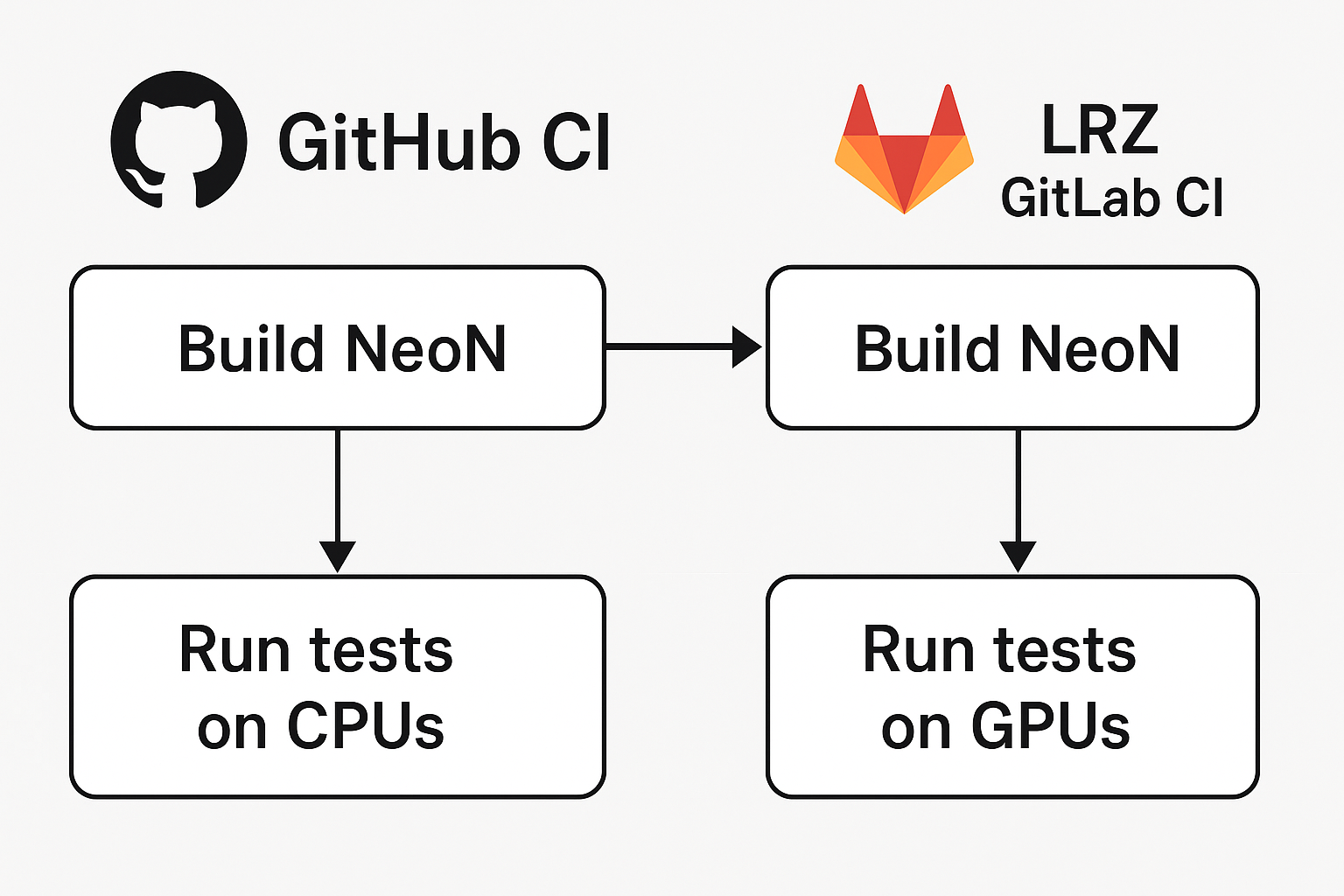Continuous Integration¶
The NeoN project uses a two-level Continuous Integration (CI) system to ensure correct builds, GPU compatibility, and automated benchmarking.
The main repository is hosted on GitHub, and GPU-based workflows are delegated to LRZ GitLab, where jobs are executed on both NVIDIA and AMD GPUs. The CI architecture for NeoN is illustrated below.

Continuous Integration on GitHub¶
GitHub CI is responsible for managing the overall NeoN CI workflow.
Responsibilities:
Build and test NeoN on CPU across different platforms (Linux, macOS, Windows).
Push the source code and commit metadata to LRZ GitLab.
Cancel outdated pipelines on LRZ GitLab for the same branch.
Trigger new LRZ GitLab pipelines for GPU builds and benchmarks.
Note
The GitHub CI acts as the control layer for all NeoN CI operations. Developers interact only with GitHub — all LRZ GitLab pipelines are triggered automatically.
Continuous Integration on LRZ GitLab¶
The LRZ GitLab CI handles GPU-related operations.
Responsibilities:
Build and test NeoN on NVIDIA and AMD GPU on Linux.
Run benchmark jobs after successful build and test stages.
Report the status and results back to GitHub for unified monitoring.
Development Workflow¶
The development workflow for NeoN proceeds as follows:
A developer opens a pull request (PR) or pushes a commit to an existing PR on GitHub.
GitHub CI builds and tests NeoN on CPUs, and pushes the same branch to LRZ GitLab.
GitHub CI cancels all pending or running LRZ GitLab pipelines for that branch.
GitHub CI triggers a new LRZ GitLab pipeline.
LRZ GitLab CI builds and tests NeoN on GPUs.
If the tests pass, GitHub CI triggers integration tests with the NeoFOAM on GPUs (see below).
(Optional) Benchmark jobs are executed after successful testing, including integration testing.
The developer monitors all results directly on GitHub.
Tip
Use the benchmark label on a NeoN pull request to trigger benchmarking jobs.
Integration Tests¶
NeoN is a CFD library that can be integrated into other frameworks. An option is to use the GitHub repository NeoFOAM, which provides an adapter to integrate NeoN with OpenFOAM.
To ensure the correctness of this integration, the CI system includes jobs that build and run NeoFOAM with NeoN. The integration tests are executed on CPUs by GitHub CI, while the integration tests on GPUs are executed by LRZ GitLab CI as illustrated below.
flowchart TD
A[GitHub CI] --> B[NeoN LRZ GitLab Pipeline]
B -->|Build & Test NeoN| C{Pipeline Success?}
C -->|Yes| D[NeoFOAM LRZ GitLab Pipeline]
D -->|Build & Test NeoFOAM using same NeoN version| E[End]
C -->|No| F[Stop]
GitHub CI triggers a pipeline on NeoN LRZ GitLab which builds and tests NeoN.
If the pipeline succeeds, GitHub CI triggers a pipeline on NeoFOAM LRZ GitLab.
The NeoFOAM pipeline builds and tests NeoFOAM with the NeoN version triggering the pipeline.
This ensures that any changes in NeoN do not break the integration with NeoFOAM.
Branch Handling Rules: When triggering the NeoFOAM pipeline, the following rules apply to determine which NeoFOAM branch to use:
If a branch with the same name as the NeoN branch exists on LRZ GitLab, it is used directly.
Otherwise, the main branch is used as a fallback.
Pull Request Labels¶
NeoN’s GitHub repository uses labels to control the CI behavior.
Relevant Labels:
Skip-build— Skip all build-and-test jobs on both GitHub and LRZ GitLab.benchmark— Enable GPU benchmarking jobs after successful build-and-test jobs and integration tests.
These labels allow developers to customize the CI process according to their needs.
Summary¶
The NeoN CI system provides:
Unified GitHub-driven CI management.
Transparent CPU and GPU build workflows.
Automatic synchronization between GitHub and LRZ GitLab.
Branch-aware pipeline handling and cancellation.
On-demand GPU benchmarking via PR labels.